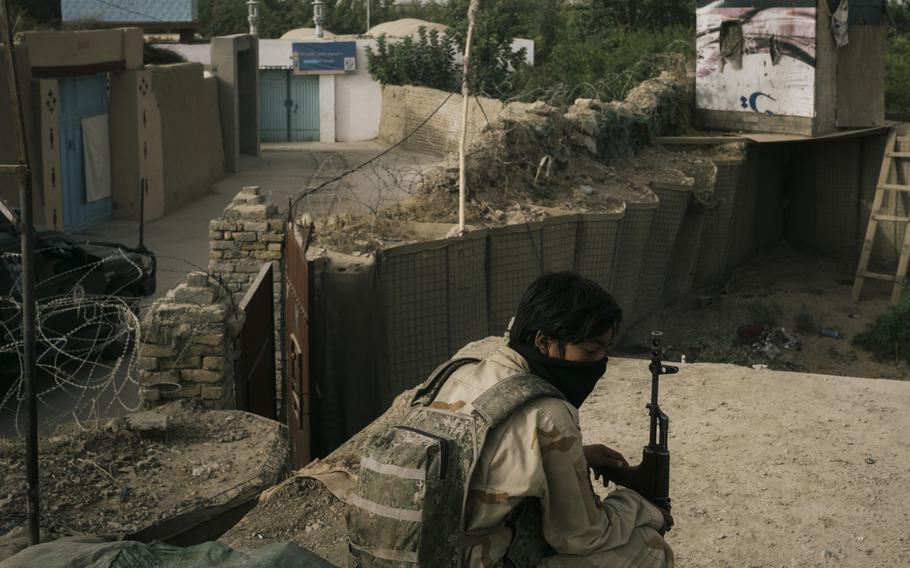
A police officer sits in an outpost in Kandahar, Afghanistan, as Afghan security forces find themselves engaged in a battle with the Taliban inside the city limits. (Lorenzo Tugnoli/for The Washington Post)
KANDAHAR, Afghanistan — Taliban forces are ramping up pressure on some of Afghanistan’s largest cities, striking busy transit hubs and pushing front lines deep into urban areas for the first time since the militants were overthrown nearly two decades ago.
Taliban fighters launched rockets Saturday at airports in Kandahar and Herat, two of the country’s largest cities and busiest economic centers. The attacks disrupted commercial travel, though flights in and out of Herat subsequently resumed.
“There was a large blast and the whole room started shaking,” said Massoud Ahmad Pashtun, the chief of Kandahar airport, who was present at the time of the attack. He said three rockets landed within seconds of each other and damaged one of the runways.
The attacks mark a potential turning point in the Afghan conflict. Previously, clashes were largely confined to the country’s rural areas or smaller cities contested by the militants. Large-scale conventional attacks on Kandahar and Herat, the second- and fourth-largest cities in the country, have the potential to endanger millions more civilians.
Initial reports suggested the Kandahar rocket attack came from the eastern side of the city, where Taliban fighters have made advances. Pashtun said he feared more attacks in the coming days, because of the deteriorating security situation and the removal of an American antimissile system that protected the airfield before the withdrawal of U.S. forces from the southern province.
Gen. Ajmal Shinwari, a security forces spokesperson, said at a news conference Sunday that all troops were on high alert due to “the emergency situations” in Kandahar and Herat. Hundreds more Afghan forces have been sent to the southern and western provinces as reinforcements.
Taliban attacks in Kandahar province have been ongoing for months, but in recent days the group began pushing closer into the city center.
Front lines that crisscrossed largely agricultural suburbs just weeks ago now span densely populated neighborhoods. Just a few hundred meters from a Taliban-held neighborhood on Kandahar’s western edge, government forces have transformed a wedding hall and an opulent multistory home into makeshift bases.
“They watch us from those houses over there,” said a commando officer, who spoke on the condition of anonymity because he was not authorized to talk to the media. He pointed out a white Taliban flag visible just a few blocks away from a traffic circle.
The government soldiers said they exchanged fire with Taliban fighters occasionally during the day, but it is at night that clashes grow more intense.
Thousands of civilians are being forced to flee their homes. Deeper inside Kandahar city, makeshift camps have sprung up in empty lots.
Jalil Ahmad, 30, said his house was destroyed by a mortar attack and his ears were still ringing from the blast. He said a police unit took up a firing position on to the roof of his home, and Taliban fighters retaliated with a volley of mortars.
“An entire wall collapsed on my family,” he said. “We have never seen fighting like this in our area before.”
In Herat, Afghan special forces were deployed to the city on Sunday to help push back Taliban advances. Taliban fighters breached the city limits and a United Nations compound was attacked, as clashed raged for hours. The U.N. condemned the attack. A Taliban statement described the destruction as “regrettable,” saying the group remains committed to protecting the U.N.
Abdul Rahman Rahman, an Interior Ministry adviser, traveled to Herat on Sunday to calm “the atmosphere of panic” growing in the city, he said. Rahman arrived with a team of Afghan special forces, which he pledged would deal “fiercely” with the Taliban.
The Taliban push on major cities comes as the group continues to squeeze much smaller provincial capitals in areas long contested by militants. In Helmand, a province that has been one of the least stable in Afghanistan for years, fighting intensified last week, heightening fears that the province’s capital would fall. Taliban fighters have pushed inside the city’s limits and are steadily closing in on the central government compound.
Afghan forces responded with a punishing wave of air support. One airstrike hit a small hospital on the city’s outskirts Saturday, killing the relative of a patient and injuring four others, including a patient and three members of staff, according to hospital director Mohammad din Naraiwal.
As the airstrikes drew closer in recent days, Naraiwal repeatedly communicated with Afghan government forces, asking them not to strike the facility. He said no Taliban fighters were present in the building when it was hit.
“I’m worried if the government resupplies their forces there will be more fighting,” he said. “There will be more civilian casualties.”
Ezzatullah Mehrdad contributed from Kabul.